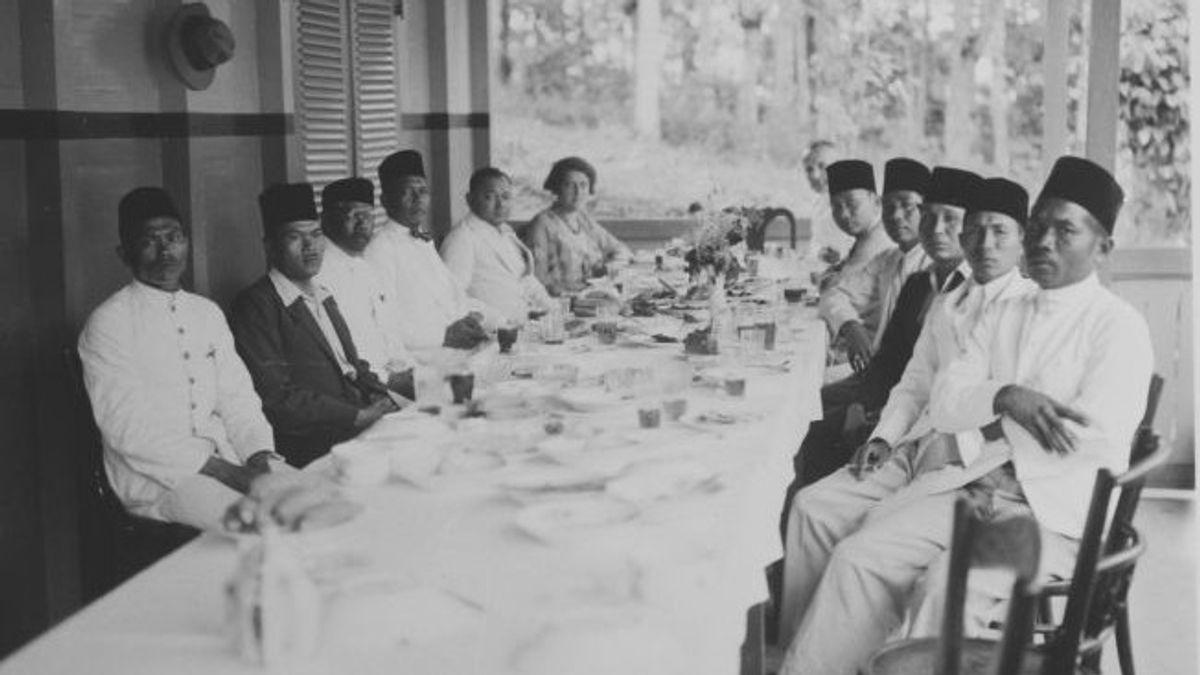JAKARTA - In every Eid al-Fitr celebration, gathering at the long table or Nyai Table is the moment most awaited by all Betawi people. The Nyai table is known to have magical powers. Magical because it can bind togetherness between family and closest friends. As well as magical because it can bring out the form of Betawi cultural diversity.
Because the Nyai table is so special, all forms of cultural fusion, from Portuguese, Chinese and Dutch can gather on it. Some of these melts come in the form of pastries such as nastar, syringe, cake one, kiji cake, dodol and various sweets. Not only that, heavy meals such as buffalo stews, cakes and red bean soup were also presented to welcome guests who came to stay in touch.
As noted by historian JJ Rizal, the location of the soul of the Betawi cultural diversity can be enjoyed from the rows of food on the Nyai table. Then, when people want to know the form to which Betawi people can accept differences, they just glance at the menus that are served.
"Ramadan is a big event, because Betawi people are often identified with Islam. However, when Eid arrives, strangely, there is almost no Islamic food, no Arabic food, the majority of food comes from the world of ethnicity, race, culture, outside the culture of ethnic race. Islam, "he said when contacted by VOI on May 22.
Rizal also added that food for the Betawi people is not just a matter of being delicious or expensive. In fact, it is more than that. The Betawi people believe that in every food served there is a value that can be a valuable lesson. "Food was not just maknyus-maknyusan, ust-ajiban, but there is no value, there is wisdom in the food. And the food we taught the value of respect and friendly living with a difference."
Diversity in food
Rizal's opinion is correct. If you trace it, the average menu that is served at the Nyai table does not have a menu that really comes from or has Arabic nuances. Nastar, for example. According to Vincent Gabriel in his book Success In The Peranakan Food Business (2015), the presence of nastar in Indonesia actually came thanks to the Portuguese settlers who came to Asia with pineapple seeds from their colony, South America.
The Portuguese often process pineapple as the main ingredient for making pineapple pie trays. Unexpectedly, the pineapple pie was also famous. By the Dutch who came after Jayakarta was conquered by the VOC trading partnership in 1619, the pie was modified in such a way that it became a cake known as nastar.
"Ananas tart (pineapple pie) was later modified by the Dutch to become nastar, as many Javanese call it."
Not only that. There are also other Dutch pastries that have been adapted into Eid snacks. Such as kaas stengels (cheesecake) and botersprits, which are adapted to the pronunciation of the Betawi people into syringes.
This row of cakes is proof that the cake, which is usually served at Christmas by the Dutch, can then be adopted and modified into one of the cakes that fill one of the food jars on the Nyai Table.
Regarding the main food is the same. Fadly Rahman, in the book Rijsttafel: Culinary Culture in Indonesia during the Colonial Period 1870-1942 (2016) explains that many Indonesian foods originating from the culinary culture of the Dutch are now becoming a mandatory menu during Eid for Betawi people. Some of them have the names of buffalo and patties.
"Semur (smoor) is a type of food that has a sweet Dutch taste using chicken or beef. This food has been adopted into a popular local dish in rijsttafel under the name Smoor Djawa (gebakken vis met een pittige sauce), ”said Fadly.
Uniquely, the combination of Indonesian and Dutch culinary culture in stews is also strengthened by the touch of Peranakan Chinese through the presence of soy sauce that complements the taste of the sweet-tasting food. Patties too. In the past, the pronunciation of cake, which is a type of food made from mashed potato in Dutch, is called frikedel.
“The difficulty in pronouncing the letter 'f' by the indigenous people caused the word frikedel to change its pronunciation to become a cake. After entering as one of the indigenous dishes, frikedel began to undergo a process of modification of ingredients such as tempeh, tofu and corn, "he added.
Appreciate differences
The young Betawi figure, Masykur Isnan, revealed that the ability of the Betawi people to make peace by including external elements in the menu lines that were served at the Nyai table was not without reason. Since long time ago, the Betawi people have been most diligent in cultivating a sense of brotherhood and a spirit of togetherness with anyone.
“The Betawi people have always been known to be very religious. For that, the Eid momentum is used as an event to prove that the Betawi people are open and very tolerant, ”he said when contacted by VOI .
"Not only that, Betawi is the result of cultural diversity and the acculturation process. So it is not surprising that the Betawi people and their noble culture are very open and tolerant of diversity and diversity. Therefore, people who know the ins and outs of the Betawi people will see Betawi as a portrait of diversity who dares to embody the meaning of Bhinneka Tunggal Ika, even though it is in the form of Eid, "he concluded.
The English, Chinese, Japanese, Arabic, and French versions are automatically generated by the AI. So there may still be inaccuracies in translating, please always see Indonesian as our main language. (system supported by DigitalSiber.id)










